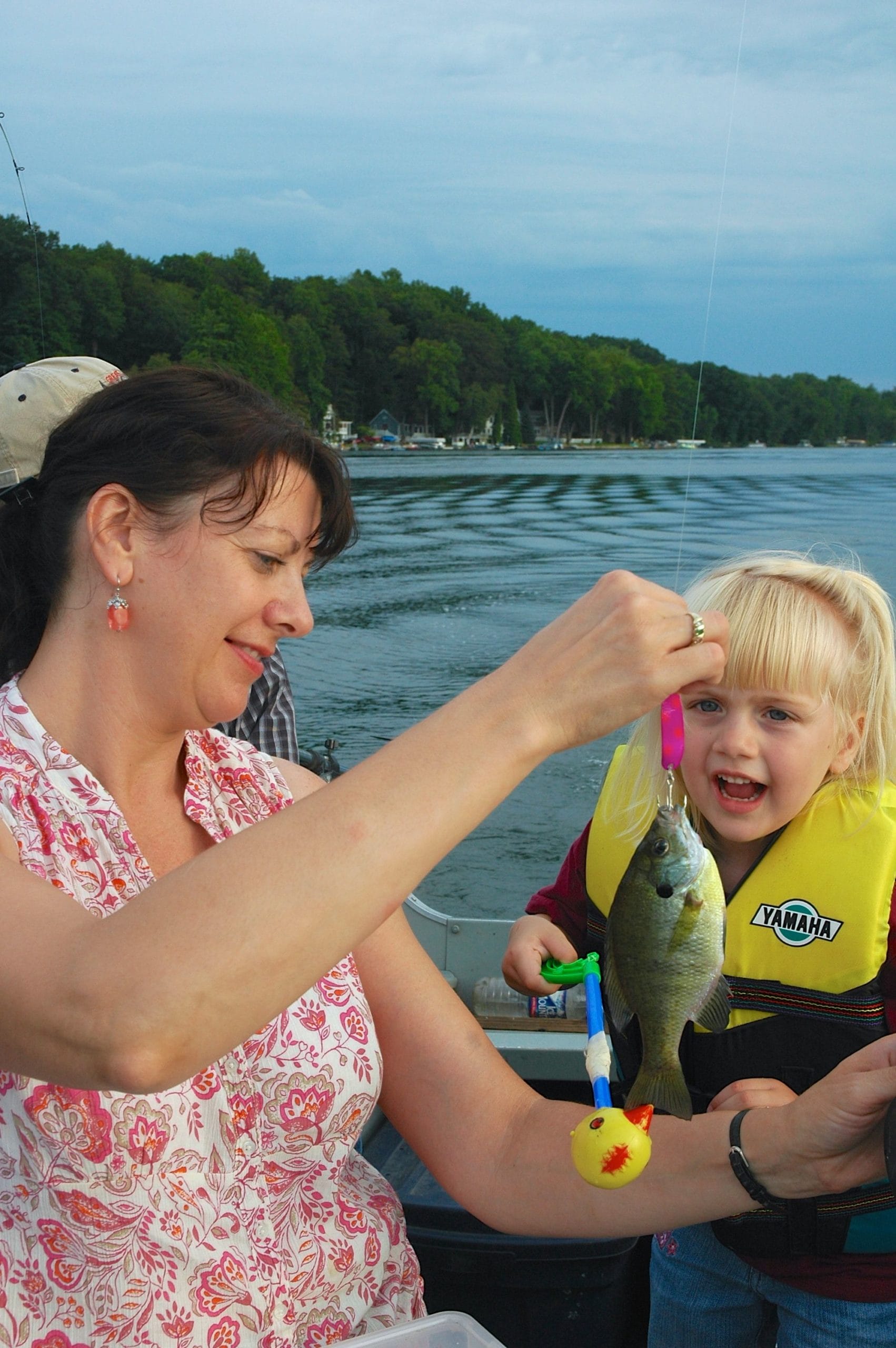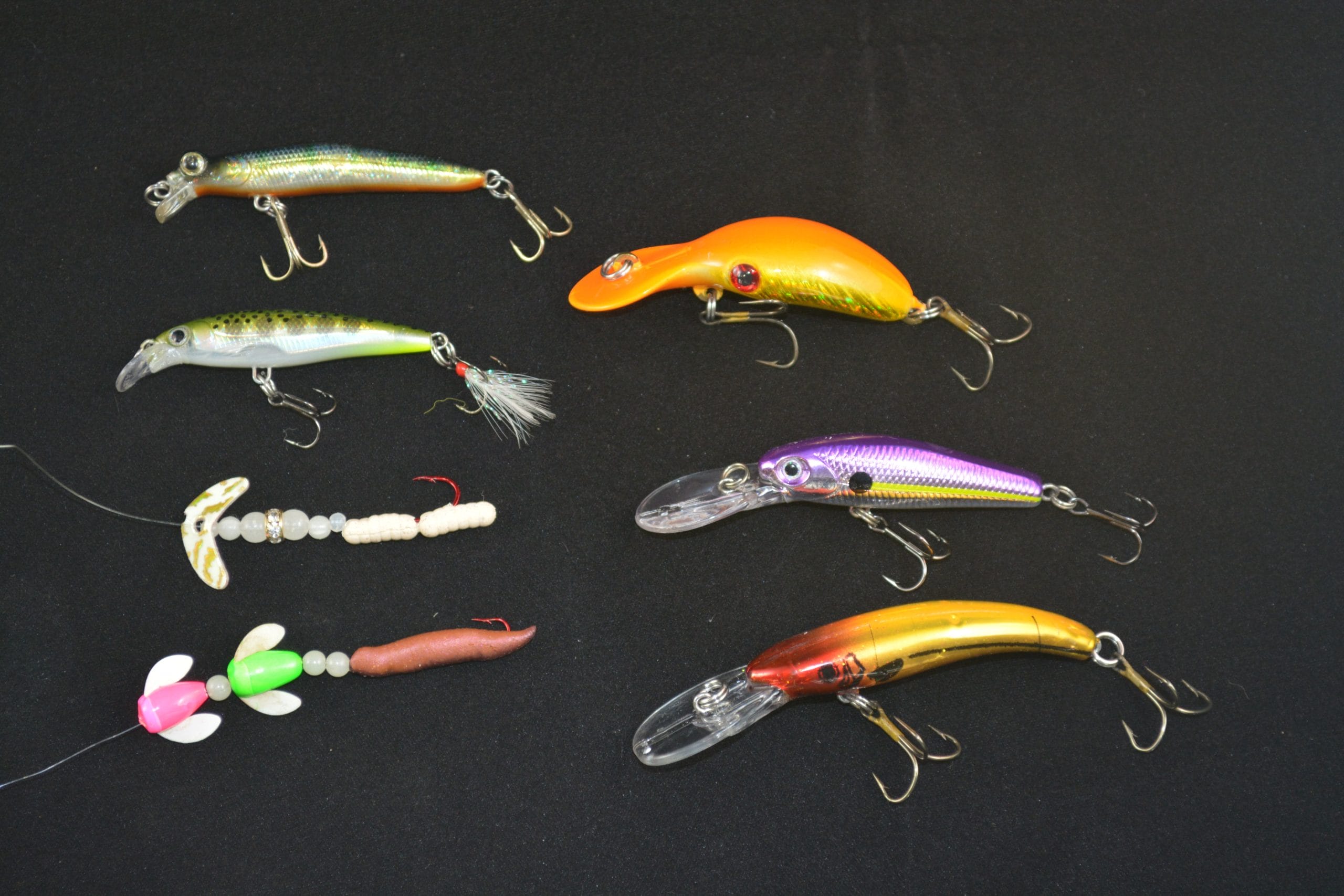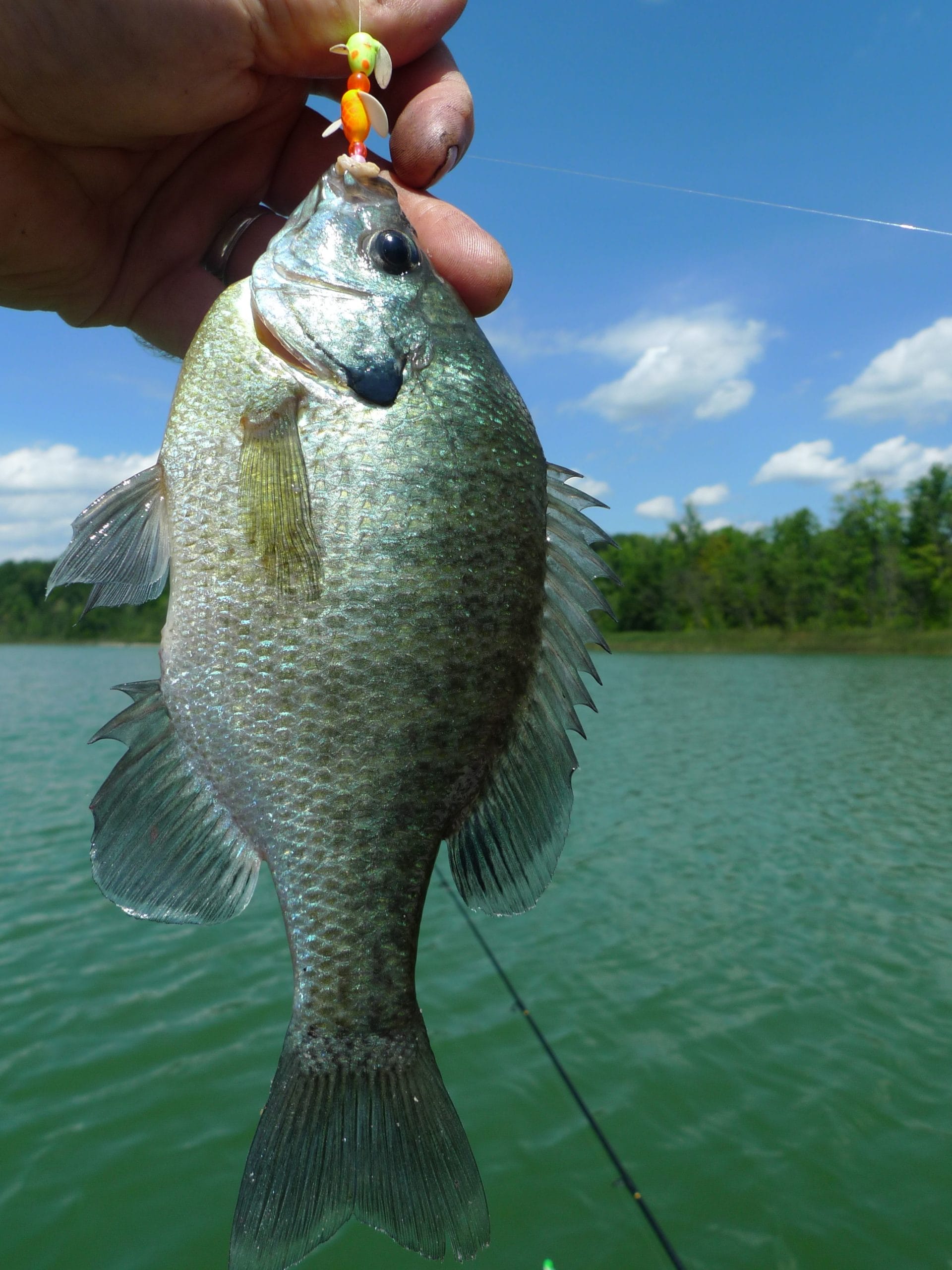by Dave Mull
A big bluegill on our trolled rig was welcome, but it was no surprise. Our targets were trout on the deep Michigan lake that August afternoon, but right away we could tell what grabbed the Stinger Scorpion spoon trolled behind a downrigger set 25 feet deep didn’t fight with a trout’s darting runs.

Trolling for bluegill is a great technique for kids to get in on the action. Here, Kathy Terpstra and Andrea Essenburg, 6, admire a bluegill Andrea reeled in after it hit a small Stinger Scorpion spoon trolled with a downrigger on a Michigan lake.
Instead, it stayed deep and struggled in a shivering circle.
“Wow, nice bluegill!” I remarked to my buddy Kevin Essenburg, who let his 6-year-old daughter Andrea reel it in.
We scored three trout and another decent bluegill before sunset, and the panfish weren’t necessarily flukes. Trolling with the solid intention of catching a mess of bream and crappies is hugely effective and pretty easy. Trolling is especially effective for bluegill in the summer, when bigger panfish move away from the weedbeds that served as their nurseries and suspend over open-water lake basins where they feed on zooplankton, emerging insects and minnows.
Trolling for bluegill isn’t a new approach for me. Each August, my grandfather used to slowly row with double-hook rigs and a bell sinker at the end of the fishing line for large bluegills. It seemed we were fishing in the middle of nowhere. With two or three flyrods coupled with old baitcasting reels and braided Dacron line, he’d present a smorgasbord of crickets, leaf worms and catalpa caterpillars to fish hanging 20 to 35 feet deep over even deeper water.
He would measure out different lengths of line and half-hitch it to the reel handle. When a fish hit, he hand-lined it in like a fly angler stripping in flyline, letting the braid coil in the bottom of the boat. Fish landed, hook rebaited, it was easy to put the bait back to the productive depth and then adjust the other lines to put more baits in the same vicinity.
In those days, before fish-finding sonar became standard issue on fishing boats, it was a hit-and-miss proposition. These days, thanks to electric trolling motors, great electronics and an assortment of lures suitable for ultra-light tackle, trolling for suspended panfish can be a hot ticket for steaming, breaded fillets fresh from the fryer.
My fishing buddy Al Malsch, of Lawton, Michigan, showed me a panfish-catching system that’s as simple as it is effective.
The key components are diminutive Worden’s Spin-N-Glos, which are basically colored cones of hard, buoyant foam with wings that spin when pulled through the water. One or two Spin-N-Glos are tied on a leader of 4-pound fluorocarbon, with a bead separating the spinner from a long-shank No. 6 hook. Bait, whether live waxworms, redworms or a small, scented artificial grub such as a Berkley Gulp! 1-inch Pinched Crawler, seals the deal with panfish drawn to the commotion of the spinner. Small metal blades and the Smile Blade from Mack’s Lures also make effective bait-trolling rigs.
In the summer, once the lake water settles into a warm surface layer above cold depths, Malsch trolls deeper water away from any structure as well as the deep side of weed beds. In an electric motor-powered, square-back canoe, Malsch sets out three rods for himself, and hands a fourth to his usual fishing buddy, grandson Tyler Malsch.
Crimping a couple of split shot ahead of the 3-foot leaders, Malsch makes sure each line is paid out a different distance to cover different depths, then he trolls just fast enough for the Spin-N-Glos to revolve. While longer rods go out to the side, one of the hottest rigs is often a 2-foot-long ice fishing rod with a tiny spinning reel. The bait is set to run in line with the Minn Kota electric motor, right behind the disturbance of the prop.
“I think the swirling of the propeller brings ’em right to the boat,” Malsch says, noting that many fish are missed by fishing too deep. “Bluegills especially are often looking for food right on the surface, so many times lines with little weight running in the top few feet of water will catch a lot of fish.
“Of course that’s not true every day, and lots of times baits taken deeper with a little more weight will get those fish hanging right at the depth where the water separates from the warm surface layer to cold water.”

A wide variety of lures work when trolling for panfish. (Clockwise from bottom left) Two Worden’s #14 Spin-N-Glos baited with a Gulp 1-inch Pinched Crawler, Mack’s Wedding Ring with two Power Bait Wigglers, Size 04 Rapala X-Rap, SPRO Mini Jerkbait, Lindy 3/16-ounce River Rocker, Storm 3 1//2-inch Mad Flash Thunderstick, and a Reef Runner Mini-Rip.
Crappie often hang right at this temperature break, technically called a thermocline, and attack bait rigs as well as small crankbaits such as Reef Runner Mini Rips, No. 4 Shad Raps and 3/16-ounce Lindy River Rockers.
The depth you fish with spinners and bait depends on the amount of weight you add to the line, how much line you let out and the speed of your boat. Crankbait depth largely depends on how deep the specific lure can dive and how far back you set it.
To achieve and duplicate effective depths, the ‘rod-sweep’ method works well. Just put the bait in the water with the rod parallel to the surface. Point the rod tip almost directly astern. With the bail open—but finger ready to stop the line—sweep your rod almost all the way to the bow.
At the end of the forward sweep, stop the line, slowly point the rod back astern, letting the lure drop back, and repeat the forward sweep. Ideally, each sweep lets out the same amount of line.
When a rod gets a bite, match the amount of line out on the other rods. You might not know exactly how deep the baits are, but you can reset them with the same number of sweeps and know you’ll to about the same depth.
This summer, give panfish trolling a try—you might be surprised at how quickly you get the fixings for a fish fry.
The Union Sportsmen’s Alliance website is designed to provide valuable articles about hunting, fishing and conservation for members of AFL-CIO affiliated labor unions and all sportsmen and sportswomen who appreciate hunting and fishing and want to preserve our outdoor heritage for future generations. If you would like your own story and experience from the outdoors to be considered for our website, please email us at USAmembers@unionsportsmen.org.




